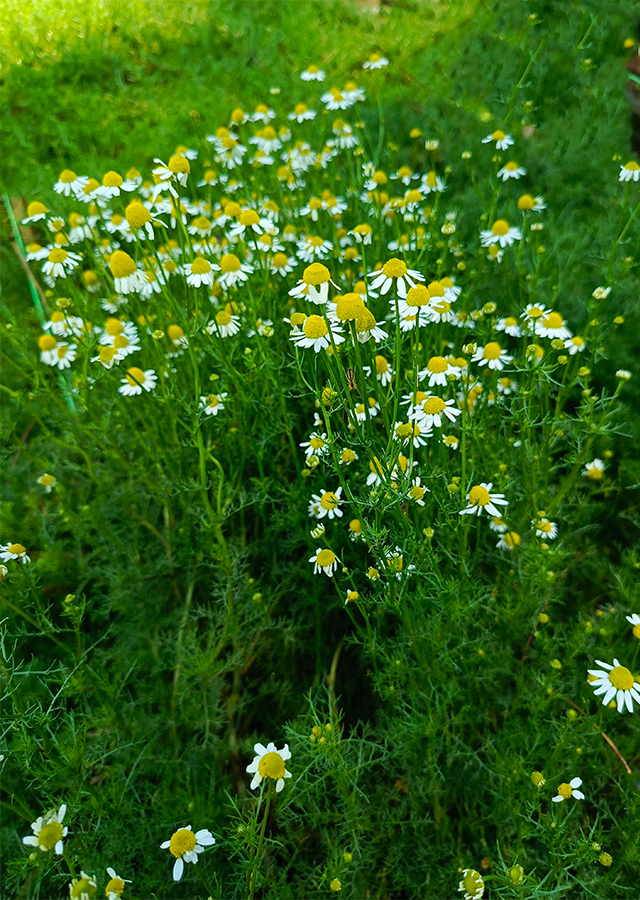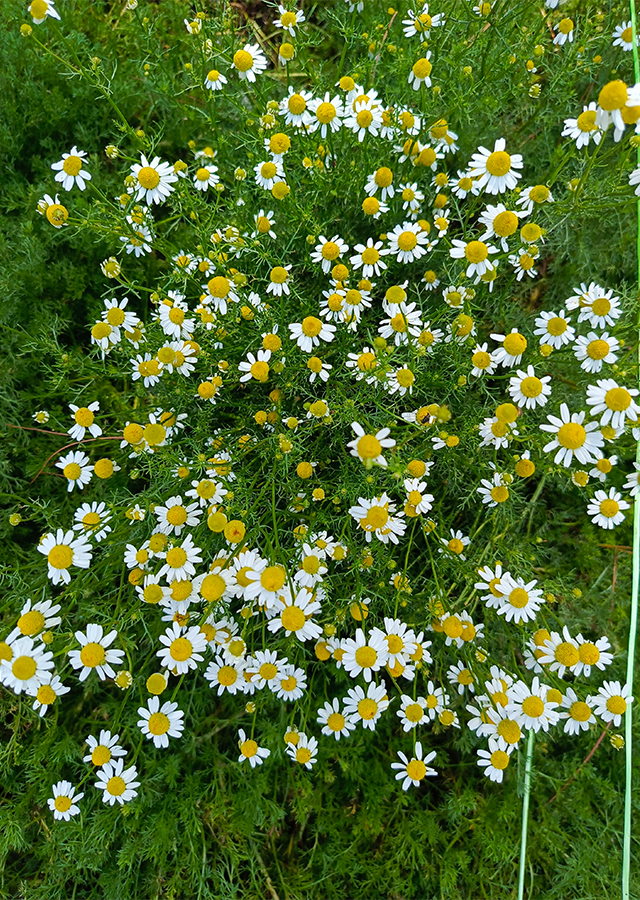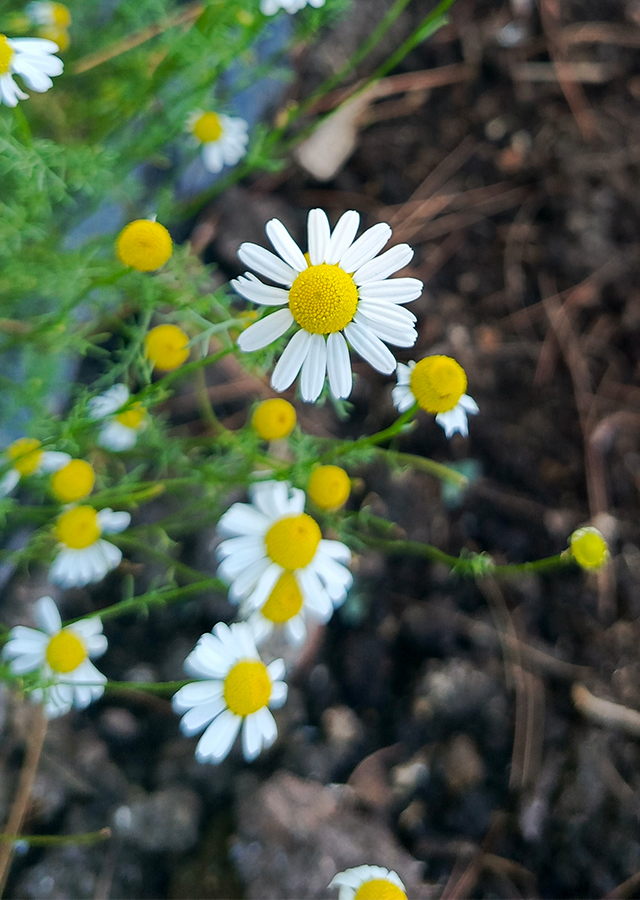Traditional Herbs from Matricaria chamomilla
overcoming_digestive_disorders
- Take enough fresh chamomile leaves, wash them thoroughly.
- Boil until boiling.
- Let it warm/cool.
- Strain then drink.
What is Matricaria chamomilla Looks like??



Parts of Matricaria chamomilla that could be used
- Leaves", "Flowers", "Stems", "All Parts of the Plant
Matricaria chamomilla Distribution
M. chamomilla is native to Southern and Eastern Europe, northern and western Asia. This species has also been introduced to many countries and has become naturalized in England, Australia, and North America. Currently, M. chamomilla is widely distributed throughout the world and cultivated. Including Germany, Hungary, France, Yugoslavia, Russia, Brazil, New Zealand and North Africa. M. chamomilla is an important medicinal herb that has been used in herbal medicine for thousands of years, known in ancient Egypt, Greece and Rome. This herb was believed by the Anglo-Saxons to be 1 of 9 sacred herbs given to humans by God. Medicinal chamomile is included in the pharmacopoeia of 26 countries. It is an ingredient of several traditional, unani, and homeopathic medicines. This plant produces essential oils that are widely used in perfumes, cosmetic creams, hair preparations, skin lotions, toothpastes, and also in fine liquids. International demand for chamomile oil continues to increase. As a result, this plant is widely cultivated in Europe and has been introduced in several Asian countries for the production of its essential oil. Apart from producing essential oils, chamomile flowers are also used in herbal teas, as well as a source of yellow to gold dye. Based on the study results, it is known that M. chamomilla shows several activities such as antioxidant, antibacterial, antifungal, anticancer, antidiabetic, antiparasitic, anti-inflammatory, antidepressant, antipyretic, antiallergic and analgesic activity. Allows M. chamomilla to be applied in the fields of medicine and veterinary medicine, food preservation, phytosanitary control, and as a surfactant and anti-corrosion agentAgroecology of Matricaria chamomilla
M. chamomilla can be found growing in empty lots, roadsides and fields. It grows best in areas where annual daytime temperatures are in the range of 19-25 °C, but can tolerate 6-30 °C. When dormant, plants can survive temperatures down to -5 °C, but young growth can be seriously damaged at 0 °C. This species is tolerant of cold weather but grows better in full sun and requires long summer days and high temperatures. M. chamomilla also grows well in areas with average annual rainfall in the range of 700-1,000 mm, but tolerates 300-1,300 mm. M. chamomilla can grow in all types of soil and is well-drained, but planting it in rich, heavy, moist soil should be avoided. Its growth also prefers neutral to slightly acidic soil pH conditions and is successful in poor soil and moderate salinity conditions.
Morphology of Matricaria chamomilla
- Thin spindle-shaped roots.
- Branched stems, erect.
- Narrow and long leaves, bipnnate to tripinnate.
- Flowers white, 11 to 27 flowers arranged concentrically. Flower heads are stalked, heterogamous. Tubular florets golden yellow with 5 teeth, about 1.5 to 2.5 mm long, always ending in a glandular tube. The base of the flower (receptacle) is 6\u20138 mm wide, flat at initially and conical, later becoming conical, hollow (a very important distinguishing feature of Matricaria).
- Cypsela fruit is yellowish brown with 3-5 faint ribs.
Cultivation of Matricaria chamomilla
- Propagation is carried out generatively by seed.
- Seed germination begins within 4\u20135 days after sowing, and is ready to be transplanted within 4\u20135 weeks. Seedlings that are more than 5 weeks old should not be transplanted, because they produce a poor harvest not good.
Matricaria chamomilla, more details :
Chemical Content of Matricaria chamomillaEssential oils (consisting of terpenoids, such as α-bisabolol and its oxides A and B, bisabolol oxide A, chamazulene, and β-farnesene), phenolic compounds (including phenolic acids, flavonoids, and coumarin).
Benefits of Matricaria chamomilla
Treats stomach disorders related to pain, sluggish digestion, diarrhea and nausea, flatulence, common cold, liver disorders, neuropsychiatry, intermittent fever, respiratory problems, fights pain and infections, cures skin diseases (herpes zoster, boils), hemorrhoids , eyes, inflammation of the mouth and throat. Has activity as antioxidant, antibacterial, antifungal, anticancer, antidiabetic, antiparasitic, anti-inflammatory, antidepressant, antipyretic, antiallergic and analgesic activity.
Simplisia of Matricaria chamomilla
- Pick enough fresh chamomile flowers.
- Wash thoroughly with running water.
- Air dry in the shade for several days or dry using an oven at 40\u00b0C until dry evenly.
- Store the simplicia in a closed\u00a0container, opaque and at room temperature.
Another Facts for Matricaria chamomilla :
Synonym of Matricaria chamomillaChamaemelum chamomilla (L.) E.H.L.Krause, Chrysanthemum chamomilla (L.) Bernh., Chamomilla recutita (L.) Rauschert
Habitus of Matricaria chamomilla
Herb. Annual herb, grows upright, reaching 10-80 cm high
Habitat of Matricaria chamomilla
- Side of the road
No comments:
Post a Comment